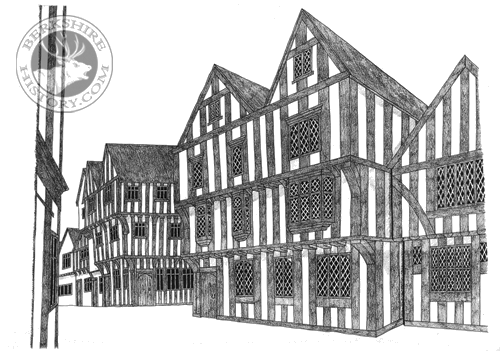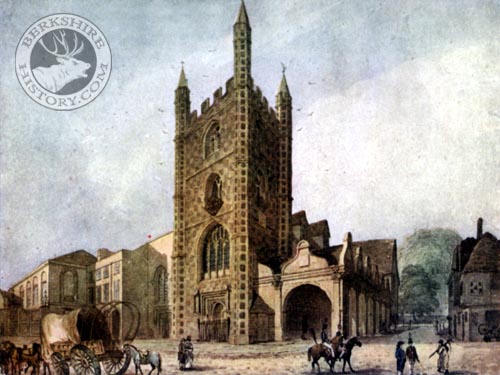|
|
|
 Reading Four Reading Four
Hundred Years Ago
A Wealthy Merchant Town
in Tudor Times
Let us try to picture to
ourselves, Reading as it
was about the end of Queen Elizabeth I's long reign (1558-1603) and the
beginning of the Stuart period. The cloth trade was then at the height
of its prosperity. It is not likely, however, that, in 1600, Reading
contained more than about 5,000 people. Most of them dwelt within the
space marked out by Old Street (now St. Mary's Butts and West Street),
Friar Street, the Market Place and the Hallowed Brook. There were,
however, a good many houses in Castle Street and in London Street. In
1610, there were no regular places of worship other than the three old
parish churches. Though it is possible that, as early as this date, a
few people may have been in the habit of meeting together privately to
worship God in their own way, since it is known that, more than a
century before 1610, there were a few Lollards (followers of John
Wycliffe) in Reading.
Much traffic, consisting chiefly of pack-horses and wagons, passed
through the town along the western road from Bristol to London, and also
along the road which led over Caversham
Bridge to Oxford. Many barges passed to and from Reading by the Kennet
and the Thames. Reading, in fact, had now become the chief town in
Berkshire and many observers praised the handsomeness of its streets and
houses.
It was a town of many bridges. In the year 1560, there were certainly
nineteen. Seven of them were in the short street which crossed the
streams of the Kennet. This street, now called Bridge Street, was then
called Seven Bridges. Further, there were six bridges between Caversham
Bridge and the remains of the Friary. Several of the brooks which these
bridges crossed have since disappeared. Caversham Bridge itself was very
ancient and curious. Part of it was wood and part was stone. Half-way
across it were the remains of the old chapel of St. Anne, in earlier
days visited by numberless pilgrims because of its celebrated relics.
All round the town, and quite close even to the main streets, there were
green fields and, within the town, there were many gardens and orchards.
The streets were, however, very narrow and crooked. Many of them were
called "rows." The houses were so built that each storey
overhung the one below it and, though their timbered fronts and numerous
gables were pleasing to behold, the effect of building thus was to shut
out light from the windows and road below. Moreover, many houses bore
swinging signs, hung out over the roadway on poles, and these signs made
things darker still. The pavement of the streets was very uneven. At
best, it consisted of flints and round pebbles rammed tightly together.
A gutter ran down the middle of the street and all kinds of refuse
collected in it. There was only one regular scavenger and his work was
to cleanse part of the town once a week. The pigs which strayed about
the streets, and the surly dogs which lurked in doorways, perhaps made
up a little for the lack of proper scavengers. There was no general
system of drainage whatever at this time. Water, never filtered, was
obtained from the rivers or out of wells. The lighting of the streets,
at night, was then and long afterwards very poor. It was thought enough
for householders to hang a lantern outside their doors on nights when
there was no moon. There were no fire engines. A few leather buckets and
some ladders were the only appliances in case of a house catching fire.
Fear of fire caused the Corporation to forbid any one to use thatch for
roofing. At nine o'clock at night, the deep voice of "Harry,"
the big bell in St.
Lawrence's tower, warned the people to go to bed and, at five
o'clock in the morning, it warned them to get up.
 It was more than sixty years since the monks had been turned out of the Abbey,
and large parts of their ancient habitation had been pulled down. But it
would seem that the tower and spire of the great church yet stood and so
also did the noble chapter house. Enough of the old house of the Grey
Friars remained in 1614 to make it a suitable lodging for Queen Anne,
the wife of James I. The house was then approached from the street
through an imposing arched gateway. The guest hall of St.
John's Hospital was used for a town hall and for a free school,
while the old dormitory of the Hospital had been turned into stables for
the King's horses. In 1611, John
Blagrave, the mathematician, left some money to make the Market
Place larger and also to build, against the side of St. Lawrence's
church, facing the Market Place, a covered walk, or cloister, for the
shelter and comfort of market women and others. In some of the old
pictures of the church this cloister may be observed. In the middle of
the Market Place were the town pump, the whipping posts, the pillory and
the stocks.
It was more than sixty years since the monks had been turned out of the Abbey,
and large parts of their ancient habitation had been pulled down. But it
would seem that the tower and spire of the great church yet stood and so
also did the noble chapter house. Enough of the old house of the Grey
Friars remained in 1614 to make it a suitable lodging for Queen Anne,
the wife of James I. The house was then approached from the street
through an imposing arched gateway. The guest hall of St.
John's Hospital was used for a town hall and for a free school,
while the old dormitory of the Hospital had been turned into stables for
the King's horses. In 1611, John
Blagrave, the mathematician, left some money to make the Market
Place larger and also to build, against the side of St. Lawrence's
church, facing the Market Place, a covered walk, or cloister, for the
shelter and comfort of market women and others. In some of the old
pictures of the church this cloister may be observed. In the middle of
the Market Place were the town pump, the whipping posts, the pillory and
the stocks.
If we study the map of Reading
in 1610, and also other sources of information, we notice many
differences in the names and arrangement of the streets. Here are a few
examples. The street now called Cross Street was then called Gutter
Lane. The east end of Broad Street was split into Butchers' Row and Fish
Street, and a cluster of houses stood in the middle of the Butts. Near
Butchers' Row were the wool hall and the cloth market.
Between West Street and the old post office were the sheep market and
the pig market. The corner by the Friary was called the Town End.
Minster Street was so narrow, and so often blocked with wagons, that, in
1648, the Corporation closed it with chains: hence nearby Chain Street.
There were archery butts in St. Mary's parish and in St. Giles's parish.
On Whitley Hill, there were some wooden houses, occasionally used for
the reception of those stricken with the plague. There was no proper
hospital for the sick or injured.
There were many inns in the town. The chief of these were the George Inn
and the Bear Inn. The George was already old, for it is said that it was
built in 1506. It still continues, but the Bear has been closed many
years past. The Ship, the White Hart and the Broad Face also existed in
the seventeenth century, but only the first remains today.
On market days, the Market Place was thronged with countryfolk,
especially towards noon. If you could visit it at such times, you would
be likely to see many curious sights. You would see the aldermen of the
Corporation going to the Town Hall in their furred gowns and the
burgesses' sons going to the Free School. Yonder, might be an Arabian
quack doctor trying to persuade people to buy his drugs; or a ragged
footpad caught in the act of cutting a woman's purse from her girdle.
Here, the people would gather round the town sergeants about to cry, in
a loud voice, a proclamation fresh from London. Yonder, would be a group
of travelling actors, anxious to be allowed to act their play in the
Town Hall; or a knot of people who professed to have discovered a witch.
Here, would be two men fighting with cudgels and the constable running
up to stop them. Seated on the ground, with their feet fast in the
stocks, might be a drunkard or two, or a man caught swearing bad oaths.
All sorts of people, travelling on the great roads, drifted through
Reading and idled about the Market Place on market days: sailors from
the western ports, soldiers on the march, fugitives from justice,
workmen without work, Irishmen and even Dutchmen, thieves and honest
folk. The constables were very anxious to prevent beggars from stopping
in the town and we even read of one official, called the "cripple
carrier," whose duty it was to carry cripples beyond the borough
boundary.
Such then was Reading about four centuries ago. The town was on the
threshold of memorable events. Those events, especially the Civil
War, were to leave lasting marks upon its life, its well-being
and upon its appearance.
From WM
Childs' "The Story of the Town of Reading" (1905)
|
 |


 Reading Four
Reading Four





 It was more than sixty years since the monks had been turned out of the
It was more than sixty years since the monks had been turned out of the